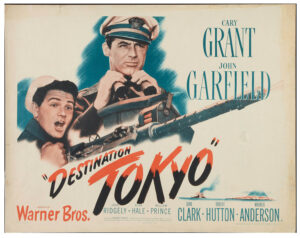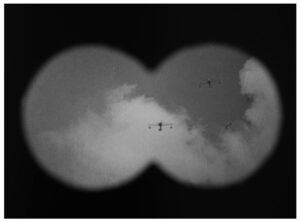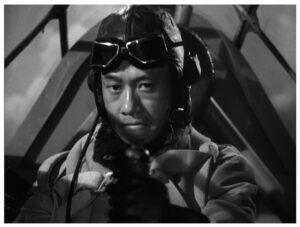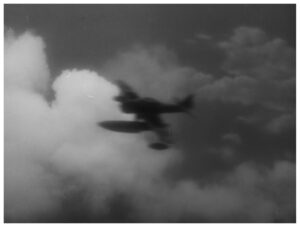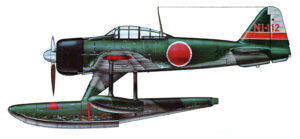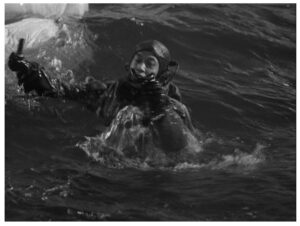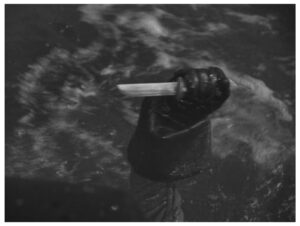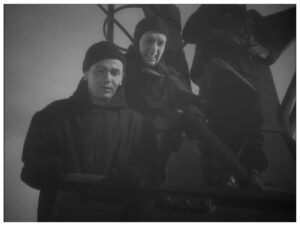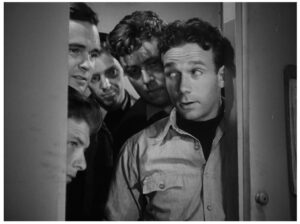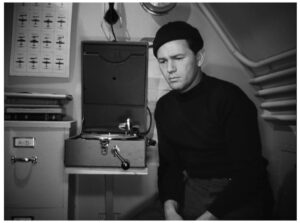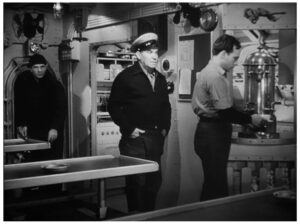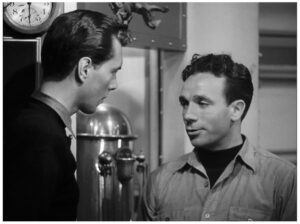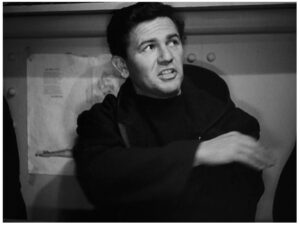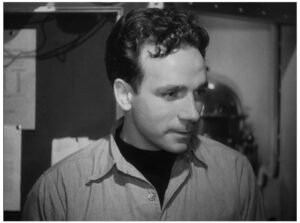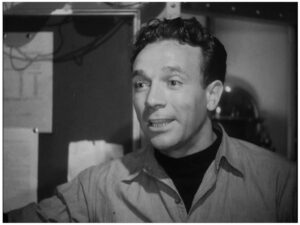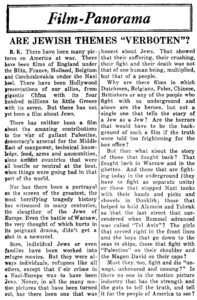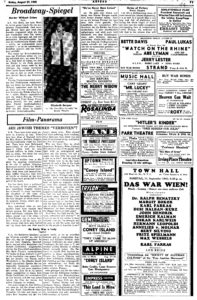“I read where an American flier gets killed and I think of my uncle.
And I see pictures of those little Chinese kids gettin’ bombed and I think of my uncle.
I read where a Russian guerilla gets hanged and I think of my uncle,
and I see Mike lyin’ in there dead from a Jap killer and I think of my uncle
and I ain’t got no room in here to see one of our guys get buried!
Not yet!
Not until I’ve done something to even up the score.”
_____
“Why are there films in which Dutchmen,
Belgians,
Poles,
Chinese,
Britishers or any of the people who fight with us underground and above are the heroes,
but not a Jew as a Jew?
Are the horrors that would have to be the background of such a film
if the truth were told too frightening for the box office?”
__________
Some movies leave a lasting impression, often in an unintended way.
For me, one such film was Delmer Daves’ production of Warner Brothers Destination Tokyo, a story about the America’s submarine service seen through the experiences of the crew of the fictional sub USS Copperfin. Released in December of 1943, the movie starred – as you can see from the poster below – Cary Grant (as sub commander Captain Cassidy), and John Garfield (as seaman “Wolf”). Other members of the cast included Dane Clark, Warner Anderson, and not to forget, Alan Hale, Sr. … the father of the “skipper” from Gilligan’s Island: Alan Hale, Jr.
__________
Destination Tokyo movie poster from Heritage Auctions.
__________
I first saw the film some decades ago (I’ve seen it a few times, since). It was broadcast (remember broadcast TV?) by a local television station to accompany a telecast of Dialing for Dollars. (Remember Janis Joplin? So yeah, this dates me!) At the time, I was in my very early teens, yet by then I’d acquired an interest in and familiarity with weapons and battles of the Second World War. This came about through paperback books – fiction and non-fiction – pumped out by publishers such as Ballantine, as well as magazines aimed at devotees of plastic modelling, specifically Scale Modeler and its sister publication Scale Aircraft Modeler (there sure as hell wasn’t much else back then other than Airfix Magazine and Model Car Science), and aviation history, particularly Wings / Airpower. The latter pair was – at the time – a quantum jump over the truly mediocre Air Classics, and was only exceeded in depth and quality by the British Flying Review International.
____________________
By way of illustration: I discovered Scale Modeler in early 1971 with the magazine’s March issue, the cover of which featured Revell’s 1/32 P-38J Lightning completed in a very colorful and highly inaccurate representation of the markings of the 459th Fighter Squadron. My reaction upon actually seeing the magazine at a newsstand? “What? Adults build model airplanes?!” Though newsstands no longer exist, having been superseded by technological and sociological changes, scale modelling has continued, but in a way enormously different from the hobby as it existed half a century ago, which might be thought of as the Paleozoic era of Plastic Modelling.
____________________
Given the time-frame of the era, it’s unsurprising that much – not all, but definitely much – of the content of these publications pertained to World War Two, given that the war had ended a mere three decades previously; that veterans of that global conflict – so many of whom I knew – were at the time the social, vocational, cultural, and political “backbone” of American (and not just American) society; that events, weapons, and technology of that conflict – though imperfectly and inaccurately described and remembered – remained part of popular culture. Yet, looking back from the vantage point of 2023, what’s remarkable was not merely the nominal presence of that generation, but how truly ephemeral and fleeting – in the face of ensuing decades of and technological, social, and ideological change, which was ongoing even throughout the course of their lives; even well before the 1920s – was their influence, impact, and legacy. (That hefty topic could be the subject of another post…)
Paralleling all this, by then – the mid-1970s – I knew “about” the Shoah, though I don’t think this specific term was then in the public lexicon. I knew about this (anecdotally and indirectly) from family members. I knew about this (tangentially) from the two-day-a-week / two-hours-a session / late-afternoon-after-public-school Hebrew School I attended, which to be fair, was probably no different in imparting a shallow (and naively well-intentioned) level of education in Jewish history, Hebrew, and Yiddishkeit than most other Conservative or Reform Hebrew Schools of the 60s and 70s.
Instead, I learned about the Shoah through my own reading, from such books as Nora Levin’s The Holocaust: The Destruction of European Jewry … though at the time I certainly couldn’t have known about historian Raul Hilberg’s claim that Levin “heavily borrowed from (Hilberg’s) own The Destruction (of the European Jews) without acknowledgment” in the crafting of her text. And, from other readings as well; both books and news articles. So, I knew that though the Shoah transpired during and within the Second World War – in time and place – it was altogether different in purpose and nature from that war. It was part of that war, yet it was another war. To put it not-so-simply (in a way I would’ve been unable to articulate at the time!), I’ll quote the late Robert Wistrich’s Hitler and the Holocaust: “…the Holocaust was driven by a millenarian, apocalyptic ideology of annihilation that overthrew all the enlightened and pragmatic assumptions of liberal modernity. This does not in itself make it different from all other genocides but it does highlight the Holocaust as an extreme case. The centrality of anti-Semitism and that of the Jews to this cataclysmic event was no accident, and this essential fact helps to explain why it resonates so strongly. For the Holocaust cannot be divorced from the dominant religious tradition of Western civilization.” And, he quotes Richard Rubenstein: “…the Holocaust [was] a modern version of a Christian holy war carried out by a neopagan National Socialist state hostile to Christianity.”
But, I wasn’t thinking about this when I ignored my homework to sit down and watch Destination Tokyo.
At least, not at at first. At least, not in those terms. I just wanted to watch a movie. I knew it was fiction. I knew it was just a story. It was (it is, still) entertaining. It was (it remains) evocative of an era.
Lots of things happen in the film, here summarized from Wikipedia:
1) The submarine departs from “Mare Island Naval Shipyard” on a secret mission.
2) Captain Cassidy opens sealed orders, directing him to proceed to the Aleutians to pick up a Navy meteorologist, and then, to enter Tokyo Bay to obtain weather intelligence for the forthcoming Doolittle Raid.
3) Two Japanese aircraft – Zero fighter seaplanes (“Rufes“) attack the Copperfin. Both are shot down, with the pilot of the second Rufe parachuting into the sea. When a crew member – “Mike Conners” – attempts to rescue the flyer (… under Captain Cassidy’s … ahem … orders …) he’s literally and explicitly stabbed in the back by the floating pilot. Recruit Tommy Adams avenges Mike by emptying a magazine of machine-gun bullets into the enemy aviator.
4) Mike dies from his wounds.
5) A bomb dropped from that “second” Rufe is lodged in the Copperfin’s superstructure. In an event remarkably similar to that aboard HMS Thrasher on Feb. 16, 1942 (for which P/O Thomas W. Gould and Lt. Peter S.W. Roberts received the Victoria Cross), the bomb is removed and defused.
6) Mike is buried at sea. Greek-American crewman “Tin-Can”, who doesn’t attend Mike’s funeral, makes a speech.
We’ll talk about this moment in a moment.
7) Tommy is diagnosed with appendicitis. “Pills”, the submarine’s pharmacist mate successfully operates and saves the man’s life.
8) The reconnaissance party – including Wolf – debarks for Tokyo Bay, successfully securing a hiding place in a coastal cave, from which they transmit encrypted weather data to the Navy.
9) The Japanese detect the transmission and search Tokyo Bay for the submarine. Undetected, the three-man team is retrieved from their hiding place. The crew observes the attack of the Doolittle raiders through the periscope. The submarine leaves Tokyo Bay the way it came in: by following a Japanese ship.
9) The Copperfin sinks an enemy aircraft carrier, but is damaged by an escort. After undergoing depth charge attacks, Captain Cassidy attacks again, sinking an enemy ship and escaping from Tokyo Bay.
10) The submarine and crew return to Mare Island.
– Finis –
The Doolittle Raid, which occurred on April 18, 1942, sets the film as transpiring during the first half of that month. As a minor point which wouldn’t have been known at the time (not that Warner Brothers or the Navy would’ve cared!), Rufes were only operational from bases at Kiska Harbor and Attu, in the Aleutian Islands, from June of 1942 through May of 1943, subsequent to the events of the movie. There, the planes served with Japan’s 5th, 452nd, and Toko Air Corps.
But…
…back to watching “Tin-Can”
As noted above, Tin-Can doesn’t participate in Mike’s funeral. However, based on the camera angle from which the sequence is filmed, his absence only becomes apparent when he’s seen in the sub’s galley, alone; in intense thought, while his fellow sailors stand at attention as Captain Cassidy leads the funeral service. Upon returning below, one crewmen gives Tin-Can the “silent treatment”, and then, Cookie, Tommy, and Wolf briefly express their anger at their fellow seaman. For a moment reluctantly, and then with increasing intensity, passion, and clarity, Tin-Can explains why he remained below as Mike’s remains were consigned to the deep. Wolf at first reacts with disgust, but then he and the other seamen listen attentively as Tin-Can continues his speech, uninterrupted. The sequence, which spans 56:14 – 58:49, comprises just 2 1/2 minutes in a movie that’s nearly 2 1/2 hours long, or (if we’re counting!) a mere two per cent of the length of the movie. But, it’s one of the very few explanatory moments in a movie otherwise centered upon action and adventure, humor and danger, and, patriotism.
Here’s the scene’s complete dialogue:
Tommy Adams: Why weren’t you up there?!
Tin-Can: I got no use for burials.
Cookie: Oh, coffee’s more important, huh?
Tin-Can: You guys don’t think I care he’s dead?!
Tommy Adams: Well why didn’t you come up? Sorry for that Jap?
Tin-Can: Shut up you, I don’t take that from nobody! I’m surprised at you guys. All of ya’! Well you ought to have sense enough not to get such – Such dumb ideas! I told ya’ I had my reasons!
Wolf: Bilge!
Tin-Can: Look. I had an uncle. Lived in the old country see. A real high-class guy, not like me. You know what he was? He was a teacher of philosophy. And to be that in Greece, the very home of philosophy, you got to be a-number-one-smart and that was my uncle. So they killed him, them Nazis. They stood him up against a wall. You know why? Because he had brains. Because everybody’s got to be their slave and them that won’t like my uncle they kill.
My old man was no good. He was a boozer. He died in bed having DTs. But my uncle, a man with education in his head and charity in his heart, who used to send my ma’ what to eat with when we were kids… Him they stood up against a wall and that sticks in here with me!
But the difference between them and us, is that with us, even the no-good gets a chance to die in his own bed. So I don’t forget my uncle. I read where an American flier gets killed and I think of my uncle. And I see pictures of those little Chinese kids gettin’ bombed and I think of my uncle. I read where a Russian guerilla gets hanged and I think of my uncle, and I see Mike lyin’ in there dead from a Jap killer and I think of my uncle and I ain’t got no room in here to see one of our guys get buried! Not yet! Not until I’ve done something to even up the score.
So I eat with it and I sleep with it… So be sore at me, you – dopes.
Tommy Adams: I’m sorry, Tin-Can.
That first time I viewed Destination Tokyo, even though I knew the film was fiction, this scene was for me – in the scheme of things – a quiet epiphany; it was unlike the rest of the film.
If I reimagine my thoughts then – in the early 1970s – from the vantage point of 2023, they would’ve gone something like this stream-of-consciousness melange: “His people are from Greece and his dad’s a drunk and his family’s poor. His uncle’s a philosopher and lives in Greece. That must mean his family’s smart. He’s talking about the people who were hurt and killed by the enemy but why doesn’t he say the words Jap and German? He talks about American pilots getting killed. That’s right they’re our guys. I read about Bataan someplace and I know what happened to our pilots they captured on the Tokyo raid and my dad told me about some B-29 guys he knew who were captured. The Japs were terrible to them. He talks about the Chinese I know the Japs were really bad to them but why doesn’t he say the word Jap? Then he talks about the Russians being treated bad by the Germans. Poor Mike killed by that Jap pilot. Wait something’s not missing. It should be here. I know the Germans were bad to everybody but hated and killed the Jews most of all. So he talks about Russians and Chinese and Greeks but why can’t he talk about the Jews?”
__________
Note!: Having created this post in mid-June of 2023, I just (it’s now early July) discovered a video of the sequence of the Rufes attacking the Copperfin, and Mike’s death, at info-peace’s YouTube channel. Appropriately entitled “Destination Tokyo (1943) Enemy Aircraft”, it was uploaded way back in May of 2021.
Here it is:
__________
Much more to follow. But before I go further, here are screen-shots of this particular sequence (captured the Destination Tokyo DVD), as well the crew’s confrontation with “Tin-Can”, just to give you an idea. You can view the full movie (380 dpi) at ok.ru/video, this sequence starting at 56:14.
__________
Rufes sighted…
__________
Rufes dive to attack…
__________
Rufe strafes submarine. (Those paired machine guns aren’t quiiite right for a Zero / Rufe. Oh, well.)
__________
Pilot leans forward as he dives to attack the Copperfin…
__________
A low pass!
__________
This profile by Don Greer shows the appearance of an actual A6M2-N “Rufe”. The painting, from Squadron-Signal’s A6M Zero in Action, shows an aircraft of the Solomon Island based 802nd Kokutai, as it appeared in January of 1943.
__________
Pilot bails out. (Canopy not at all right for a Zero / Rufe. Oh, well. Must’ve been a Warner Brothers stage prop.)
__________
Pilot lands in sea and cuts himself free from his shroud lines.
__________
Captain Cassidy: “Pick up that Jap Aviator, I want to question him!”
__________
Mike tells downed Japanese pilot in comradely manner: “Looks like the war is over for you, son!” Camera focuses on knife in pilot’s upraised hand as Mike momentarily diverts his attention…
__________
…and then, the pilot stabs Mike – poor unwary and trusting Mike – in the back.
__________
Wolf and Tommy look on in horrified realization of what’s happening. Then, Tommy commences firing machine gun at enemy pilot.
__________
The magazine is emptied of bullets. Wolf to Tommy: “That’s enough, kid.”
__________
58:49: Tin-Can and fellow crewmen listen to a recording made by Mike’s wife, on sub’s record player. As the recording becomes more personal and intimate, they leave, one by one.
__________
54:10: Wolf continues to listen, alone, but he, too – even a lothario – can listen no more.
__________
54:43: Tin-Can remains in the galley, flipping playing cards, as Mike is buried at sea.
__________
56:22: Captain Cassidy: “And whilst we consign his remains to the deep …”
__________
56:06: Crewmen return to galley and confront Tin-Can
__________
56:26: Tommy and Tin-Can.
__________
56:36: Cookie and Tin-Can
__________
56:39: Cookie, Tin-Can, and Tommy
__________
57:09: Tin-Can tries to explain the reason for his absence at Mike’s funeral. Wolfe’s reply: “Bilge!”
__________
57:10: Tin-Can’s speech
__________
57:29: Tin-Can’s speech
__________
57:33: Tin Can’s uncle: “He was a teacher of philosophy.”
__________
57:47: Crewmen listen to Tin-Can, in silence.
__________
57:32: “Not until I’ve done something to even up the score.”
Back to the film…
Some things; things ostensibly minor; things ostensibly trivial but in reality significant, kind of “stick with you” and in time demand explanation. As a movie buff, I really wanted to know what went on in the writing of this movie. So I watched it again, did a little looking, and did a little thinking.
The film’s credits reveal that the screenplay was by Delmer Daves and Albert Maltz, the story by Steve Fisher, and the production by Jerry Wald and Jack L. Warner. I suppose that by this point, eighty years later, the relative contributions of each to the final script will never be known. Regardless, it seems that Tin-Can’s speech, which notably occurs near the film’s halfway point and thereby interrupts action with thought, provided a way to explain the moral basis of America’s participation in the war: First by personalizing the film in terms of Tin-Can’s family (read: ethnic) history, then, from the perspective of another branch of American military service (aviation), and finally, in terms of two other principal Allied powers: The Soviet Union, and, China. (Funny that Australia, Canada, and Great Britain aren’t mentioned.) And so in terms of what puzzled me as a kid – “Hey why didn’t Tin-Can say Jew?“, part of the explanation was simply that the Jews, without then having a nation-state and collective political and military power of their own and as such not directly active in the war as a nation-state, were entirely beyond from the writers’ scope of thought.
The Jews were irrelevant.
Maybe.
But then again…
Jerry Wald was a Jew, as was Jack Warner. In unsurprising irony, so, too, was “Tin-Can”, played by Dane Clark, born Bernard Elliot Zanville. So too, “Wolf”, played by John Garfield, born Jacob Julius Garfinkle. And Albert Maltz, as well. And so I can’t help but wonder: Given the tenor of the times, were Tin-Can’s comments about his family really a veiled allusion to the fate of European Jewry? His Greek background symbolic of a family ancestry rooted in the the Levant? His philosopher uncle a stand-in for intellectuality, and, the study of the Talmud and Tanakh? Was Tin-Can speaking on behalf of studio heads, writers, and actors who wanted to bring the plight of the Jews of Europe before the American public, but for all their success and prominence – or precisely despite of their success and prominence – did not have the confidence to openly do so for fear of risking their social acceptability? The Warner studio certainly did produce films that supported America’s war effort and were openly critical of German militarism and the Third Reich. But, the tenor of the times and self-perception of those Jews who had attained high levels of status and public recognition in American society would mitigate against going so far as to call attention to the Shoah in clear, unambiguous, and explicit terms. As well, though Albert Maltz’s relative contribution to the script is unknown, what is known is that he was an unapologetic Communist. Could his ideology have imparted the sense of universalism in the seaman’s speech? (Maybe.)
Then again, perhaps interpreting Tin-Can’s 1943 speech this way is really interpreting the past through the eyes of 2023.
But still, even in mid-1943, four months before the release of Destination Tokyo, the issue was confronted in Aufbau’s August 27 editorial “Are Jewish Themes “Verboten?” by “H.K.”, probably Helen Kantzler, one of Aufbau’s rare publications of a news item in English. If the author indeed was Kantzler, it was also she who authored an article that appeared in Pittsburgh’s Jewish Criterion in late September of 1946, entitled “Double Gold Stars“, which profiled American Jewish families who lost multiple sons during the recently ended world war.
Her question about the principle of telling the truth is as valid in 2023 as it was in 1943, for it will always be valid.
Film-Panorama
ARE JEWISH THEMES “VERBOTEN”?
H.K. There have been many pictures on America at war. There have been films of England under the Blitz, France, Holland, Belgium and Czechoslovakia under the Nazi heel. There have been Hollywood presentations of our allies, form gigantic China with its four hundred millions to little Greece with its seven. But there has not yet been a film about Jews.
There has neither been a film about the amazing contributions to the war of gallant Palestine, democracy’s arsenal for the Middle East of manpower, technical knowledge, food, arms and ammunition, alone against countries that were all hostile or neutral at the best, when things were going bad in that part of the world.
Nor has there been a portrayal on the screen of the greatest, the most horrifying tragedy history has witnessed in many centuries, the slaughter of the Jews of Europe. Even the battle of Warsaw, the very thought of which hurts in its poignant drama, didn’t get a shot in a newsreel.
Sure, individual Jews or even families have been worked into refugee movies. But they were always individuals, refugees like all others, except that their crime in a Nazi-Europe was to have been Jews. Never, in all the many motion pictures that have been turned out, has there been one that was honest about Jews. That showed that their suffering, their crushing, their fight and their death was not that of one human being, multiplied, but that of a people.
Why are there films in which Dutchmen, Belgians, Poles, Chinese, Britishers or any of the people who fight with us underground and above are the heroes, but not a Jew as a Jew? Are the horrors that would have to be the background of such a film if the truth were told too frightening for the box office?
But then what about the story of those that fought back? That fought back in Warsaw and in the ghettoes. And those that are fighting today in the underground (they have to fight as separate units) or those that stopped Nazi tanks with their hands and picks and shovels in Dunkirk; those that helped to hold Alamein and Tobruk so that the last street that surrendered when Rommel advanced was called “Tel Aviv”? The girls that served right in the front lines and the boys that go down to the sea in ships, those that fight with “Palestine” on their shoulder and the Magen David on their caps
Must they, too, fight and die “unwept, unhonored and unsung?” Is there no one in the motion picture industry that has the strength and the guts to tell the truth, and tell it for the people of America to see?
The original editorial…
…the editorial as it appeared in the newspaper.
So to conclude, here’s the “what if” version of Tin-Can’s speech:
Look. I had an uncle. Stayed in the old country. A real mensch, not like me. Know what a mensch is? It’s Jewish for a true man. A decent man. Ya’ know what he did? He was a rabbi. Taught poor kids. A cobbler, too. Could hardly feed and clothe my aunt and cousins. But so respected. So they killed him, them Germans. We found out, last year. Took the whole family – my three cousins – uncle, aunt – stuck ’em in a ghetto. Took ’em all – everyone in the ghetto – and shot ’em. Everyone. Y’know why? Because they were Jews. Like me. That’s all. Because the damned no-goods want to kill every Jew. Anywhere. Everywhere.
My old man was lost to us. He was a boozer. Smart, like my uncle. Loved to learn and study Hebrew books, but there’s no place for that in America. So see my mom, she worked in a shirt factory while pop turned to drink and dreams. And drink. He wandered off; we don’t know where. Don’t want to know. My pop, the dreamer… But my starving uncle, the rabbi … see, he sent us charity. Because of him my mom and sisters and me … had what to eat. Had heat in the winter. Him and my cousins and aunt the Germans stood over a ditch and shot and that sticks inside me.
But the difference between them and us, is that with us, even the no-good gets a chance to die in his own bed. I read where an American flier gets killed and I think of my uncle. And I see pictures of those little Chinese kids gettin’ bombed and I think of my aunt. I read where a Russian guerilla gets hanged and I think of my little cousins. And I see Mike lyin’ there dead from a Jap killer and I ain’t got no room in me to see one of our guys get buried! Not yet! Not until I’ve done something to even up the score. For my family. For the Jews. For Mike. For my country. For them all.
So I eat with it and I sleep with it… So be sore at me, you – dopes.
Tommy Adams: I didn’t know, Tin-Can.
See?
I fixed it for you.
(There you go.)
______________________________
Destination Tokyo movie poster from SensCritique. It’s obviously based on the horizontal-format poster (at the top of this post!), but redesigned for a theater marquee.
____________________
Suggested Viewing
“Destination Tokyo” (1943)
… Full Film (380 dpi) at ok.ru/video
Trailer…
____________________
____________________
…For Further Pondering…
Suggested Reading
Bueschel, Richard M., Mitsubishi A6M1/2-2N Zero-Sen in Imperial Japanese Naval Air Service, Aero Publishing Company, Inc., New York, N.Y., 1970
Haynes, Stephen R., Reluctant Witnesses – Jews and the Christian Imagination, Westminster John Knox Press, Louisville, Ky., 1995
Kellerman, Henry, Greedy, Cowardly, and Weak – Hollywood’s Jewish Stereotypes, Barricade Books, Fort Lee, N.J., 2009
Nirenberg, David, Anti-Judaism – The Western Tradition, W.W. Norton & Company, New York, N.Y., 2013
Nohara, Shigeru, A6M Zero in Action (Aircraft Number 59), Squadron/Signal Publications, Carrollton, Tx., 1983
Wistrich, Robert, Hitler and the Holocaust, Weidenfeld & Nicolson, London, England, 2001
____________________
Suggested Listening
Henry Kellerman’s Oral History, at Yiddish Book Center
____________________
Suggested Remembering
C A S T
Dane Clark (Bernard Elliot Zanville) – “Tin Can” – 1912-1998
…at Internet Movie Database
…at FindAGrave
John Garfield (Jacob Julius Garfinkle) – “Wolf” – 1913-1952
…at Internet Movie Database
…at FindAGrave
See also!…
“John Garfield: Hollywood’s First Rebel”, at Cinema Cities.
“Bursting onto screens in 1938, Warner Brothers star Garfield captivated audiences with his unparalleled talent, charisma, and a unique style that set him apart from his contemporaries. Garfield’s on-screen presence was magnetic, his performances filled with raw emotion and authenticity. Whether portraying a troubled anti-hero, a conflicted lover, or a defiant underdog in films like “Four Daughters,” “Body and Soul,” “Humoresque” and “The Postman Always Rings Twice,” he breathed life into every character he inhabited, leaving an indelible mark on cinema history.
Beyond his remarkable acting abilities, Garfield was a trailblazer in his own right. He fearlessly tackled societal issues and pushed boundaries with his choice of roles, often shining a light on the harsh realities of the time. His commitment to his craft and unwavering dedication to social justice resonate even today. However, his unwavering stance against injustice came at a price. Accused of harboring Communist sympathies, he was blacklisted by HUAC.”
____________________
Gary Grant (Archibald Alec Leach) – “Captain Cassidy” – 1904-1986
…at Internet Movie Database
…at FindAGrave
Alan Hale, Sr. (Skipper’s father!) – “‘Cookie’ Wainwright” – 1892-1950
…at Internet Movie Database
…at FindAGrave
Robert Hutton (Robert Bruce Winne) – “Tommy Adams” – 1920-1994
…at Internet Movie Database
…at FindAGrave
Tom Kane Tully – “Mike Conners” – (1908-1982)
…at Internet Movie Database
…at FindAGrave
W R I T E R S
Delmer Daves 1904-1977
…at Internet Movie Database
…at FindAGrave
Steve Gould Fisher 1912-1980
…at Internet Movie Database
… at FindAGrave
Albert Maltz 1908-1985
…at Internet Movie Database
…at FindAGrave
Et Cetera
The Doolittle Raid
…at Wikipedia
Mitsubishi A6M Zero
…at Wikipedia

